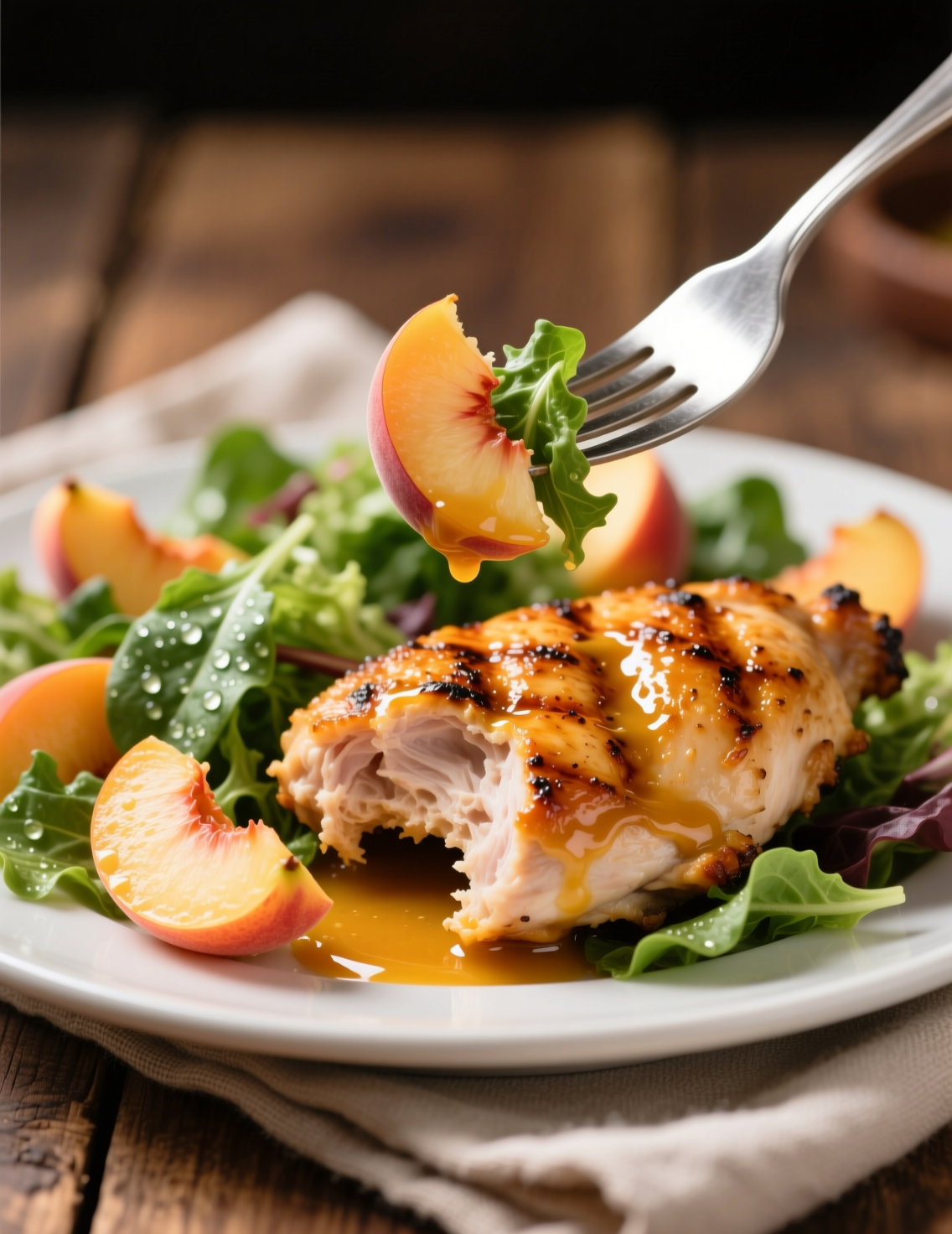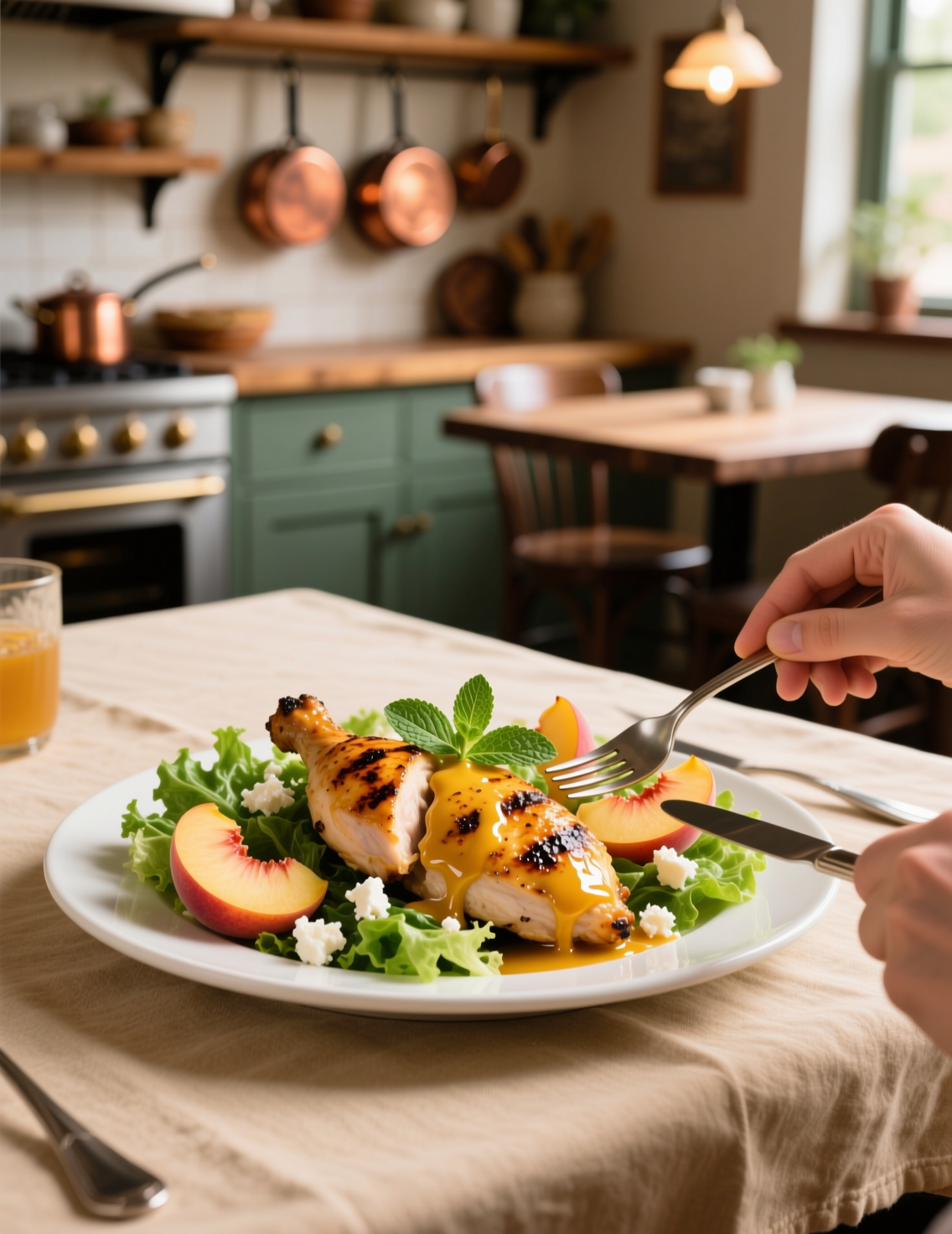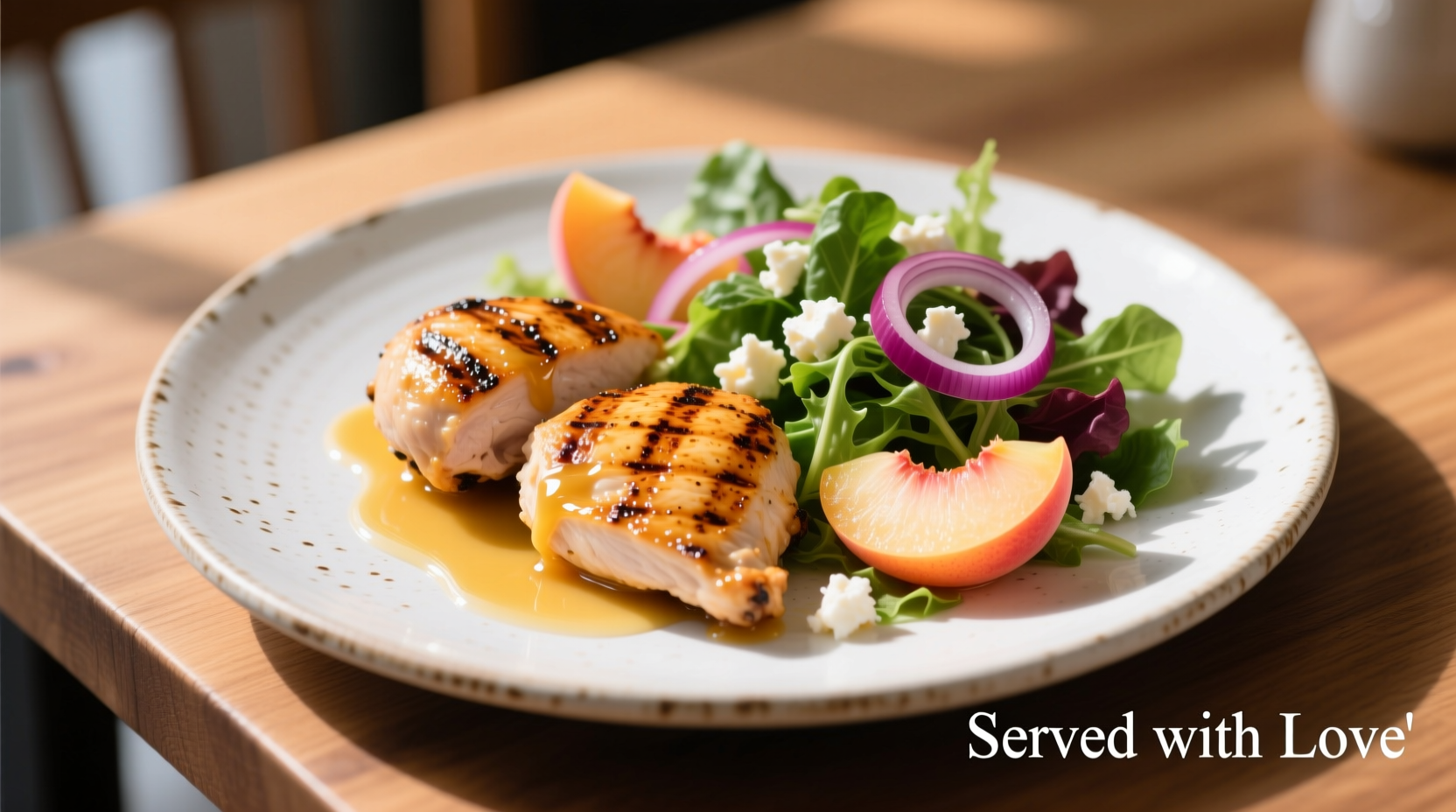There are recipes that feed you, and there are recipes that tell a story on the plate. Grilled honey mustard chicken with peach salad belongs in the second camp. It’s a dish that feels like summer caught in a moment, then tucked into a bowl. Professionals who cook daily, whether in restaurants, test kitchens, or culinary schools, already know how tricky balance can be—sweet, tangy, smoky, and fresh must sit together without crowding one another. This recipe does that dance beautifully.
Why This Recipe Matters
At first glance, honey mustard chicken looks like a casual backyard dish. But professionals know it’s all about nuance. The glaze has to cling without burning. The peaches need to keep their bite without turning to mush. And the salad must refresh the palate, not compete with the chicken’s smokiness. This is where technical skill meets restraint.
The pairing isn’t accidental either. Studies in sensory science have shown that contrasting flavors increase satiety and enjoyment. A 2019 research paper from the Journal of Sensory Studies highlighted that sweet-tart combinations stimulate appetite more strongly than single-note flavors. Honey mustard with peaches leans on that science, but in a way that feels effortless.
The Chicken: Building Layers of Flavor
Honey mustard glaze is simple on paper, but real execution is about ratios. Too much honey and the sugar caramelizes too quickly, giving bitter edges. Too much mustard and the acidity dominates. The professional trick is balance—roughly 2 parts honey, 1 part Dijon mustard, and 1 part whole-grain mustard, with a squeeze of lemon juice to cut richness.
Grilling adds another dimension. Direct high heat creates Maillard browning, which boosts umami notes. Professionals know to oil the grill grates lightly, otherwise sticky honey chars into unpleasant black patches. Chicken breasts are lean, so marinating first helps. A short two-hour soak in the glaze softens the fibers and lets flavor seep in. Don’t over-marinate—long exposure to mustard’s acidity makes the texture mealy.
Choosing the Right Chicken Cut
Boneless, skinless breasts work well for this recipe, but thighs hold flavor better. In kitchens where cost efficiency matters, thighs also offer consistency—they’re less prone to drying. That said, in fine dining plating, a perfectly grilled breast looks cleaner. Professionals might choose a hybrid approach: breast for presentation, thigh for staff meal. Both cuts benefit from being pounded lightly to even thickness, ensuring uniform cooking.
USDA research confirms that chicken must hit 165°F at its thickest point for food safety. But chefs rarely cook it right to 165°F over fire. They pull at 160°F and let carryover heat finish the job. This keeps the meat juicy instead of stringy.

Honey and Mustard: Ingredient Quality
Honey isn’t just sweet—it brings floral and earthy undertones depending on source. Clover honey is mild, while wildflower or orange blossom add more character. In professional kitchens, sourcing local honey isn’t just marketing fluff—it supports terroir, gives stories to servers, and adds subtle depth diners can actually taste.
Mustard deserves equal respect. Dijon provides backbone with sharp acidity, but whole-grain mustard gives visual texture. That speckled appearance against golden grill marks elevates plating. The combination also helps balance mouthfeel—creamy smoothness with tiny bursts of crunch.
The Peach Salad: Freshness on the Plate
Peach salad isn’t filler. It’s contrast, deliberately designed. When peaches are in season, their sweetness feels alive. A firm-ripe peach slices cleanly without gushing juice all over the board. For this salad, you want that balance—juicy enough to refresh, structured enough to hold shape.
Pairing peaches with arugula or baby spinach adds a peppery, green bite. Toasted pecans bring crunch and richness. A drizzle of light vinaigrette—olive oil, champagne vinegar, a pinch of salt—ties it all together. Professionals sometimes grill the peaches lightly, just enough to kiss them with char, which deepens flavor without collapsing texture.
Ingredient Science: Why Peach Works Here
From a flavor chemistry angle, peaches carry lactones, compounds that give creamy, fruity aromas. These molecules pair well with mustard’s isothiocyanates, which give sharpness. Sweet plus sharp creates a cognitive “refresh and return” cycle, where diners crave alternating bites. This principle is also why wine pairings often lean on contrasts—acidic whites with buttery sauces, for example.
Nutrition science backs the pairing too. Chicken offers lean protein, while peaches provide fiber, vitamin C, and antioxidants. A serving delivers balanced macros without the heaviness of cream-based dressings or starch-heavy sides. In performance kitchens—think athletes’ meal plans—this matters a lot.
Practical Prep Tips from Pros
One mistake even skilled cooks make is brushing glaze too early. Honey caramelizes fast, so apply most of the glaze during the final minutes of grilling. Start with a thin coat before searing, then build layers. This ensures color without burnt sugar.
Another overlooked step is resting. Let the chicken sit five minutes before slicing. This isn’t a chef cliché—it’s muscle fiber science. Resting lets juices redistribute, preventing that frustrating puddle of liquid on the cutting board.
For the salad, dress greens lightly just before plating. Professionals never toss delicate leaves too early; acid breaks them down quickly, leaving a wilted mess. If prepping for service, keep vinaigrette separate until firing the dish.
Plating Considerations
Presentation is part of professional cooking. Place grilled chicken sliced on the bias over a bed of greens, peaches fanned around the edge. Sprinkle pecans and a crumble of feta or goat cheese if desired. The visual of golden chicken with blush-colored fruit draws the eye. In a restaurant setting, this dish thrives in wide, shallow bowls. It looks abundant without appearing heavy.
Textures matter too. The chew of chicken, crunch of nuts, soft sweetness of peaches, and peppery greens give a multi-layered eating experience. Diners remember textures more than they realize. A 2016 Cornell University study showed textural contrast increases reported satisfaction by 28%. This dish benefits directly from that principle.
Adapting for Different Contexts
For catering, professionals might skewer chicken cubes, glaze them, and serve over peach salad in cups. In fine dining, the glaze could be reduced into a thin brush stroke across the plate. In casual dining, sandwiches with grilled chicken, peach slices, and arugula work as spinoffs. Recipes like this flex across service models because the flavor structure is solid.
Common Mistakes and Fixes
Burning glaze is the number one issue. Solution: indirect heat. Move chicken to cooler grill zones after initial sear, finishing gently while brushing glaze.
Another mistake is mushy salad. Overripe peaches look good but collapse in vinaigrette. Professionals know to test ripeness with a slight thumb press—firm with just a whisper of give.
Lastly, over-seasoning. Honey mustard already delivers strong flavors, so go light on salt. Remember cheese or nuts add salinity too.
Emerging Trends in Pairings
Fruit with protein isn’t new, but it’s trending again. Chefs worldwide are reimagining savory-sweet plates as diners seek lighter, fresher menus. In 2024, Datassential’s Flavor Report ranked “fruit-forward savory” in its top 10 rising trends. Peach and chicken fit squarely into this.
There’s also a sustainability angle. Stone fruits like peaches thrive in many climates, making them a lower-impact seasonal choice compared to tropical imports. For kitchens focusing on farm-to-table narratives, this recipe highlights local abundance.

Recipe: Grilled Honey Mustard Chicken with Peach Salad (4 servings)
Ingredients
- 4 boneless chicken breasts or thighs, pounded to even thickness
- 1/3 cup honey (local if possible)
- 3 tbsp Dijon mustard
- 3 tbsp whole-grain mustard
- 2 tbsp olive oil
- Juice of half a lemon
- Salt and pepper to taste
Salad
- 4 cups arugula or baby spinach
- 3 ripe but firm peaches, sliced
- 1/3 cup toasted pecans
- 1/4 cup crumbled feta or goat cheese (optional)
- 3 tbsp olive oil
- 1 tbsp champagne vinegar
- Pinch of salt
Method
- Whisk honey, mustards, olive oil, lemon juice, salt, and pepper. Reserve a few spoonfuls for glazing.
- Marinate chicken in mixture for 2 hours refrigerated.
- Heat grill to medium-high. Oil grates lightly.
- Grill chicken 5–6 minutes per side, brushing with reserved glaze during last 3 minutes. Pull at 160°F, rest 5 minutes.
- Toss greens with olive oil, vinegar, and salt.
- Plate greens, top with peaches, pecans, and cheese. Slice chicken and arrange over salad. Drizzle any remaining glaze lightly on top.
Professional Insights
This dish isn’t just a recipe—it’s a teaching tool. It shows how marination, caramelization, and textural balance create harmony. It also illustrates menu versatility. And it underscores seasonality as a flavor driver. For culinary professionals, these aren’t just ideas, they’re daily practice.
When plating for guests, remember the story. “Local honey glaze, summer peaches, crisp greens” is language that sells. Guests don’t just buy food—they buy the narrative of freshness and craft.
Conclusion
Grilled honey mustard chicken with peach salad works because every detail has a reason. Sweetness and acidity balance. Protein and fruit complement. Science and art meet in one plate. For professionals, it’s more than a meal—it’s an example of restraint and precision, executed with seasonal flair.
Next time you grill chicken, think about what it sits beside. Think about how mustard’s heat talks to peach’s sweetness. Think about the story you want the plate to tell. That’s how simple recipes turn into professional signatures.
FAQs
What cut of chicken works best for this recipe?
Both breasts and thighs work, but thighs stay juicier while breasts look cleaner on the plate.
How long should I marinate the chicken?
About 2 hours is enough—longer makes the texture mealy from the mustard’s acidity.
Can I grill peaches for the salad?
Yes, a light char adds depth without turning them mushy.
What type of honey is best for the glaze?
Local or floral honeys like orange blossom give richer flavor than generic clover.
How do I stop the glaze from burning?
Apply most of it during the last few minutes of grilling, not at the start.
What’s the ideal serving temperature for chicken?
Pull it off the grill at 160°F and let carryover heat bring it to 165°F.
Can this recipe be adapted for catering or events?
Yes, chicken can be skewered and served over salad in cups for easy service.
What greens pair best with peaches?
Arugula adds peppery bite, while baby spinach gives a softer, milder base.
Is the salad dressing heavy?
No, it’s a light vinaigrette made with olive oil and champagne vinegar.
Can this dish be made ahead of time?
You can marinate and prep salad ingredients in advance, but assemble just before serving.

Mariana is a passionate home cook who creates delicious, easy-to-follow recipes for busy people. From energizing breakfasts to satisfying dinners and indulgent desserts, her dishes are designed to fuel both your body and hustle.
When she’s not in the kitchen, she’s exploring new flavors and dreaming up her next recipe to share with the Foodie Hustle community.

